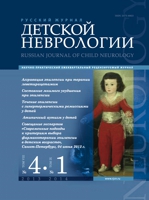ELECTROENCEPHALOGRAPHY IN THE CLINICAL PRACTICE: THE PROBLEM OF MODERN CLASSIFICATION
- Authors: Gulyaev S.A.1
-
Affiliations:
- Svt. Luka’s Institute of Child Neurology and Epilepsy, Moscow
- Issue: Vol 9, No 1 (2014)
- Pages: 35-41
- Section: AUTHENTIC ARTICLES
- Published: 18.04.2015
- URL: https://rjdn.abvpress.ru/jour/article/view/10
- DOI: https://doi.org/10.17650/2073-8803-2014-9-1-35-41
- ID: 10
Cite item
Full Text
Abstract
One of the most important problem of modern clinical electroencephalography (EEG) – the almost complete absence of classification, understandable and useful for doctors, based on the basic principles of medical semiotics with determination of individual symptoms and syndromes, which allows the clinicians to use the classification as a diagnostic tool for diagnostics of various pathological conditions. Currently, the clinical neurologist can use two classifications of EEG that are not quite accurately reflecting the clinical picture of the existing pathology. The author proposed a review of neurophysiological EEG classification of H. Luders to create a unified classification of EEG, which could be equally used for practical doctors, neurophysiologists and other specialists.
Keywords
About the authors
S. A. Gulyaev
Svt. Luka’s Institute of Child Neurology and Epilepsy, Moscow
Author for correspondence.
Email: sergruss@yandex.ru
Russian Federation
References
Supplementary files






